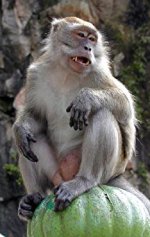 The Crab eating macaque (Macaca fascicularis) lives in South-east Asia. It is also known for the fact that it is one of the monkey species flown into space. Despite its name, it practically is an omnivore and eats anything it can get its hands to. Its diet is composed of fruits and seeds by 60 - 90%. Where crab-eating macaques live close to humans, this omnivorous behavior will become a problem and the macaque is seen as a crop-raider and a litterer, pushing over garbage cans to look into them for food. The Crab-eating Macaque's native range is the widest of any monkey. Partly because the wild harvest of macaques for medical testing has ended, because these are captive-bred now... Depending on the source, they are "near threatened" or "Lower Risk - Not Threatened".
The Crab eating macaque (Macaca fascicularis) lives in South-east Asia. It is also known for the fact that it is one of the monkey species flown into space. Despite its name, it practically is an omnivore and eats anything it can get its hands to. Its diet is composed of fruits and seeds by 60 - 90%. Where crab-eating macaques live close to humans, this omnivorous behavior will become a problem and the macaque is seen as a crop-raider and a litterer, pushing over garbage cans to look into them for food. The Crab-eating Macaque's native range is the widest of any monkey. Partly because the wild harvest of macaques for medical testing has ended, because these are captive-bred now... Depending on the source, they are "near threatened" or "Lower Risk - Not Threatened". Image by Andrew Lih, licensed under ShareAlike 2.0.
The Crab-eating macaque, cynomolgus monkey, long-tailed macaque is listed as Near Threatened (LR/nt), is close to qualifying for or is likely to qualify for a threatened category in the near future, on the IUCN Red List of Threatened Species
Countries
Brunei, Burma, Cambodia, India, Indonesia, Malaysia, Palau, Philippines, Singapore, Thailand and VietnamLong-tailed macaque habitats
Forest, Subtropical / Tropical Dry forest, Subtropical / Tropical Mangrove Vegetation Above High Tide Level and Temperate forestSome facts about the
Long-tailed macaque
Adult weight : 6.363 kg (13.9986 lbs)
Maximum longevity : 39 years
Female maturity :1238 days
Male maturity : 1544 days
Gestation : 165 days
Weaning : 242 days
Litter size : 1
Litters per year : 1
Interval between litters : 431 days
Weight at birth : 0.32 kg (0.704 lbs)
Weight at weaning : 0.848 kg (1.8656 lbs)

Custom Search